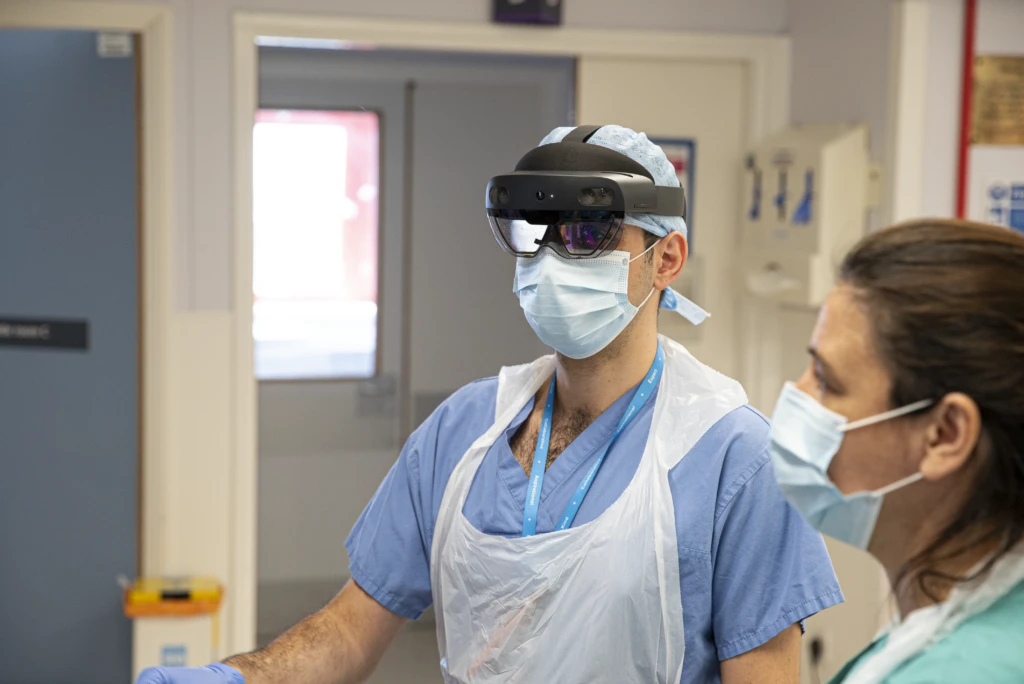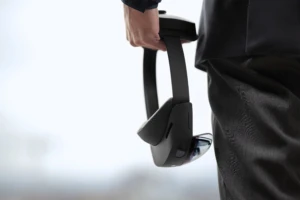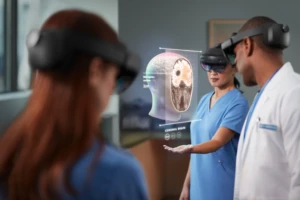
HoloLens and Dynamics 365 Remote Assist: What technology is needed to get started?
 This is a part of a series of posts about how the HoloLens and Dynamics 365 Remote Assist helps the NHS provide patient care. See the other blog posts here.
This is a part of a series of posts about how the HoloLens and Dynamics 365 Remote Assist helps the NHS provide patient care. See the other blog posts here.
In March, we rolled out Microsoft Teams for free to assist throughout COVID-19. Recently, the NHS announced it chooses Microsoft 365 to create a truly joined-up service. Both of these mean that innovations such as Microsoft HoloLens 2 and Dynamics 365 Remote Assist are far easier to adopt and use. A core requirement for Dynamics 365 Remote Assist is Microsoft Teams. Therefore, having the licenses and end-user adoption has allowed NHS Trusts to start deploying in days with limited friction. Often those familiar with HoloLens will say to others, “It’s heads-up Teams” and there is an immediacy of understanding.
Built-in security
To deploy new technology during challenging conditions, it was critical that its security met the needs of the NHS. Being natively integrated with Microsoft security technologies (like Azure Active Directory), the HoloLens 2 and Dynamics 365 Remote Assist can provide a security solution for connectivity. Leveraging Microsoft Intune to provide remote Mobile Device Management to easily configure and manage the devices. Azure Active Directory Conditional Access helps secure user access to the service. These allowed the NHS to meet their security needs whilst providing an excellent end user experience.
Conditional Access meant that the staff using the device could pick up a headset and have the minimum number of username/password prompts to quickly get working, whilst keeping the account secure with Multi-Factor Authentication against unwanted authentication attempts. Additionally, Microsoft Intune provided the ability to restrict the applications on the device to only a permitted list (Multi-app Kiosk Mode) to both minimise training time, and increase device security. Connectivity to the internet was achieved by using existing Wi-Fi networks with Microsoft Intune deploying security PSK or certificate based Wi-Fi profiles to the devices as appropriate for the secured networks available in the use locations.
It’s all about the data…

With any system collecting video or audio data, strict data governance requirements come into play to ensure patient privacy and confidentiality. Since the NHS had already adopted Microsoft Teams, this was simple to achieve. All the video and audio data collected through Dynamics 365 Remote Assist is subject to the same regulatory processing and storage requirements as Microsoft Teams. This means that the solution can be approved with the data protection teams confidently. They know that the data would be protected and meet the requirements already approved and in place.
Licences Required:
To implement the above design one of the following sets of licences is required:
- Microsoft Dynamics 365 Remote Assist
- and ONE of the following
- Microsoft 365 Enterprise E3
- OR
- Microsoft Enterprise Mobility and Security (EM+S) E3
- OR
- Azure Active Directory Premium P1 AND Microsoft Intune AND a suitable Microsoft Teams licence (for example Office 365 E3)
- Microsoft 365 Enterprise E3
Best practice tips
 Colin Brown, CCIO at University Hospitals of Morecambe Bay NHS Foundation Trust has shared that to support the purchasing of the HoloLens 2, a key enabler was digital leader discussions. Because they already have a full Microsoft tech stack, the IT department commitment was straightforward. They had early expert engagement with their Infection Prevention Team so were able to develop a standard operating protocol. This was to ensure the headset could be protected and cleaned in a virus-laden clinical environment.
Colin Brown, CCIO at University Hospitals of Morecambe Bay NHS Foundation Trust has shared that to support the purchasing of the HoloLens 2, a key enabler was digital leader discussions. Because they already have a full Microsoft tech stack, the IT department commitment was straightforward. They had early expert engagement with their Infection Prevention Team so were able to develop a standard operating protocol. This was to ensure the headset could be protected and cleaned in a virus-laden clinical environment.
Some additional great tips:
- Ensure a good deployment of Office 365 and Microsoft Teams.
- Ensure good co-design of use cases in acute provider, community, wider health and care systems, and between clinical leaders and IT.
- Develop conversations with consultant enthusiasts and digital leaders.
- Spend the time to get the first couple of end-users up and running on their first Dynamics 365 Remote Assist call. Once they have done a couple, they’ll start using it consistently.
How do you acquire HoloLens?
We have partnered with Insight who are one of our key mixed reality partners and an authorised reseller of the HoloLens 2. They can also advise on solutions, provide deployment, and managed services alongside custom development for apps on the HoloLens 2.
Insight’s Dynamics 365 Remote Assist Fast Start offering for the NHS
 Insight has packaged the best practices and created a free Remote Assist Fast Start for NHS organisations who purchase HoloLens 2 through Insight.
Insight has packaged the best practices and created a free Remote Assist Fast Start for NHS organisations who purchase HoloLens 2 through Insight.
This is designed for organisations considering Dynamics 365 Remote Assist with HoloLens 2, with mobile devices, or have HoloLens but haven’t started to actively deploy. The goal is to help get you going with minimum fuss. They’ll be using the best practices that we have garnered to get you up and running quickly.
This includes an introduction to HoloLens 2, Dynamics 365 Remote Assist overview, typical use cases in healthcare, technical considerations, and licenses. In addition, they will work to understand where you are at in your Teams deployment, walking you through steps for implementation.
Most importantly, they will take you through the HoloLens 2 out of the box experience, through to your first Dynamics 365 Remote Assist call.
Once you get set-up through this process, we will look forward to integrating you into the NHS Teams collaboration site that we have, for community Q&A and in sharing best practices.
Find out more
How HoloLens and Dynamics 365 Remote Assist helps the NHS provide patient care
Defining and implementing Dynamics 365 Remote Assist use cases
Measuring patient and clinical effectiveness
What’s next: How can other NHS Trusts get involved?
About the author
 Leila has been working on the commercial mixed reality business for the last five years and is based in the UK. She’s been working with some of the most advanced customers and partners in the world, helping them identify, pilot and deploy technologies that have a profound ability to transform their business.
Leila has been working on the commercial mixed reality business for the last five years and is based in the UK. She’s been working with some of the most advanced customers and partners in the world, helping them identify, pilot and deploy technologies that have a profound ability to transform their business.
Prior to joining the mixed reality team, she held several senior positions at Microsoft including leading consumer and commercial business units such as Server & Tools and Windows in the UK and Central & Eastern Europe.




